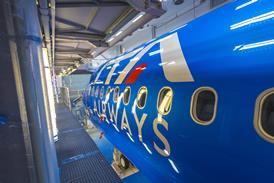MICHAEL PHELAN / LONDON
Engine programme will now focus on hardware development and component integration
Aerojet has completed manufacture and integration testing of a xenon propellant management system (PMS) for phase one of NASA's evolutionary xenon thruster (NEXT) next-generation ion engine development programme.
The hardware was tested at NASA's Glenn Research Center (GRC) on a 0.4m (1.3ft) ion thruster engineering model. A prototype digital control interface unit was also tested.
Scott Neish, vice president operations at Aerojet's Redmond, Washington, facility, says a key feature of the system is an ability to deliver varying, precise power output. "The NEXT PMS provides throttleable control of all three xenon flow inputs to the ion thruster and represents a significant reduction in mass and volume over the current state-of-the-art NSTAR [Deep Space 1 (DS 1)] design," he says.
The power output of 2-6kW is controlled by varying the thruster discharge and neutraliser cathode flow rates.
The NEXT programme is a two-phase effort to develop a next generation ion thruster system for space science missions, designed to be significantly lighter and smaller than the DS 1 unit.
Compared to the DS 1's ion engine, the NEXT PMS internal volume is reduced by a factor of 10, limiting residual gas losses when the thruster is turned off and improving throttle rate. The PMS has a mass of less than 18kg (40lb) for a three-thruster system, compared to 9.2kg for the single thruster xenon-fuelled unit on the DS-1.
NEXT is funded by the In-Space Propulsion Program in the Solar System Exploration Division of NASA's Office of Space Science, which last year awarded $21 million to the GRC to develop a next- generation ion propulsion system. Phase two is a two-and-a-half-year option to complete hardware development, integrate the components into a full-scale system and perform thruster wear tests.
Source: Flight International




















